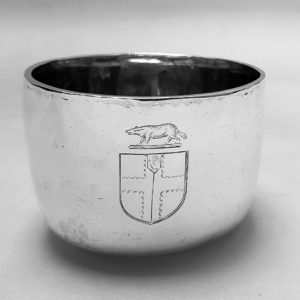Katherine Mangy
Kath(erine) Mangie or Mangy, widow of Edward Mangie (1634 – 1685).
Edward Mangie, aged 25, bought his Freedom of Hull and set up business in Church Lane, Hull. Possibly the son of Henry Mangie, a locksmith of York, whose uncle was a goldsmith (related to Thomas Mangy, York silversmith, active 1659-1683?). Edward married Katherine Spalding of York in 1661.
The Mangie workshop produced mainly tankards, tumbler cups and trefid spoons and also produced ceremonial maces for the Hull and Grimsby Corporations. After Edward’s death in 1685, his widow Kath continued the business, striking her own ‘KM’ mark. Their son Edward bought his Freedom and joined the firm in 1695. Kath died in 1725 and Edward junior carried on the business which was still operating in 1739.
Hull is a northern city with a history of silversmithing dating back to the 14th century and possibly before. Early examples had the letter “H” as town mark which was replaced in the 17th century by the arms of the town “three ducal coronets in pale”. When provincial silver marking was formally abolished in 1696 silversmiths were expected to send their wares for hallmarking at one of the official assay offices (London, Exeter, Chester, York, Norwich, Bristol and Newcastle). York was the nearest to Hull, and after York’s closure in 1714, silver would have been sent to Newcastle. Despite the act, many of the Hull silversmiths seem to have worked on regardless, although the majority were probably retailers rather than manufacturers.
Katherine Mangy
Kath(erine) Mangie or Mangy, widow of Edward Mangie (1634 – 1685).
Edward Mangie, aged 25, bought his Freedom of Hull and set up business in Church Lane, Hull. Possibly the son of Henry Mangie, a locksmith of York, whose uncle was a goldsmith (related to Thomas Mangy, York silversmith, active 1659-1683?). Edward married Katherine Spalding of York in 1661.
The Mangie workshop produced mainly tankards, tumbler cups and trefid spoons and also produced ceremonial maces for the Hull and Grimsby Corporations. After Edward’s death in 1685, his widow Kath continued the business, striking her own ‘KM’ mark. Their son Edward bought his Freedom and joined the firm in 1695. Kath died in 1725 and Edward junior carried on the business which was still operating in 1739.
Hull is a northern city with a history of silversmithing dating back to the 14th century and possibly before. Early examples had the letter “H” as town mark which was replaced in the 17th century by the arms of the town “three ducal coronets in pale”. When provincial silver marking was formally abolished in 1696 silversmiths were expected to send their wares for hallmarking at one of the official assay offices (London, Exeter, Chester, York, Norwich, Bristol and Newcastle). York was the nearest to Hull, and after York’s closure in 1714, silver would have been sent to Newcastle. Despite the act, many of the Hull silversmiths seem to have worked on regardless, although the majority were probably retailers rather than manufacturers.
-


Circa 1690
Katherine Mangy
10186 William and Mary Antique Hull Silver Tumbler Cup
Sold
A rare item of English provincial silver from Hull in the North of England. An antique silver tumbler cup of simple plain design. Good gauge silver and excellent patina. The round and weighted base allows the cup to stay upright when knocked from side to side. This example, typical of Hull silver tumblers, has a flatter base than those made in London. To the front is a hand engraved armorial with a badger crest for the Brooke family. To the reverse are owner’s initials “AD to IS”. Contains 170 ml. Weight 116 grams, 3.7 troy ounces. Height 5.4cm. Diameter 7.3cm. Hull circa 1690. Maker Kath Mangy (Jacksons page 473). Sterling silver.